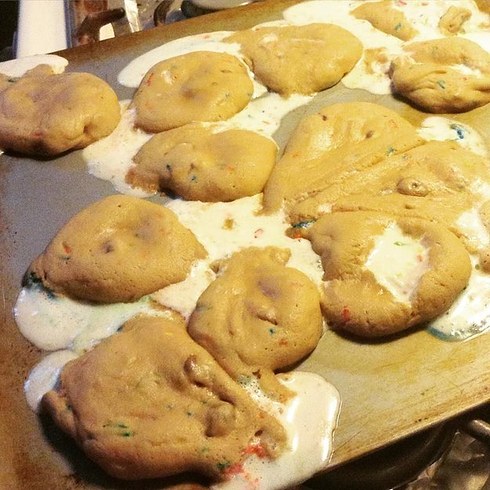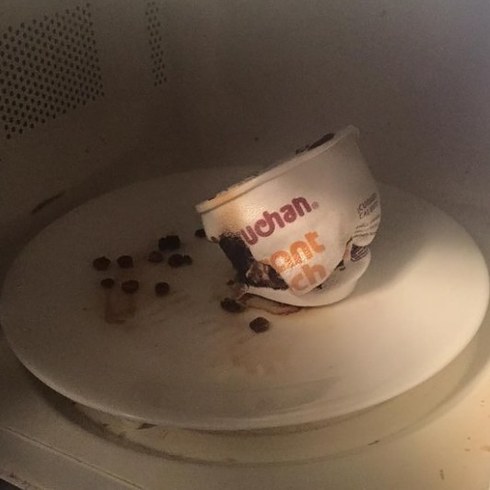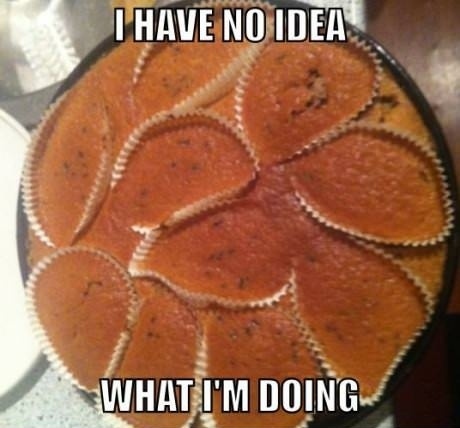Do you relate on a deeply emotional level to Pinterest Fails, cooking fail videos, and this comic by The Oatmeal?
Many people I speak to about my book, Cooking Through College, insist
to me, time and budget aside, “I just can’t cook!” The fear of burning cookies
or setting the house on fire while they try to boil water is overwhelming, and
they’ll resort to anything but learning this essential life skill.
If you didn’t grow up helping a parent or older sibling out
in the kitchen, moving out to face that first college dorm or apartment’s
decade-old stovetop with unrecognizable brown stains burned into the drip pan
is, frankly, terrifying. Many college students resort to ramen, unhealthy
freezer-aisle meals, or eating out rather than try out of fear they’ll fail.
But these, eventually, turn unsustainable, for either your health or your
budget. Or, you realize last-minute that you can’t bring instant noodles to a
potluck.
So you’ll break out the rusty, faded memories of whatever
your mom or dad was doing with that marinara sauce and pasta, or a Pinterest
recipe you’ve been craving since you saw that photo of gooey cheese. And then
it takes hours longer than you thought it would, because how were you supposed
to know that the chicken had to thaw? Or that cakes had to cool? While you
watch that green digital clock tick closer to your deadline, you decide to cut
a few corners. It won’t matter so much, right?
 |
| What did cookies ever do to you??? |
Let me assure you: This has happened to every chef and cook out there. Everyone botches at least one recipe
beyond all salvation and repair, and resorts to a bread-and-butter sandwich at
the end of the day because their energy has been spent. Four years ago, as I
stared hopelessly into a pan of burnt seasonings and veggies that was supposed
to be homemade chicken soup (yes, I have successfully burnt soup!), I could never have imagined that
I’d later write a cookbook. My secret? Getting up and trying again—maybe not
that same day, but try I did.
That, and learning why recipes fail. Like with writing or
art, there are rules you have to learn before they can be broken or improved
on.
Rule #1: Have patience!
The reason behind most of those Pinterest fails? The frustrated cooks behind them tried to cut corners and save themselves a little extra time, only to regret it when they opened the oven. Understand that cakes have to cool before you frost them, pastries in the oven are done when they’re done and will suffer if you impatiently open the door to check on them before it’s safe to do so (about halfway through the cook time, FYI), and frozen foods often need to thaw before you try making them. Understand that if the recipe says to let the dough chill in the fridge for an hour prior to baking, there’s probably a good reason.
The reason behind most of those Pinterest fails? The frustrated cooks behind them tried to cut corners and save themselves a little extra time, only to regret it when they opened the oven. Understand that cakes have to cool before you frost them, pastries in the oven are done when they’re done and will suffer if you impatiently open the door to check on them before it’s safe to do so (about halfway through the cook time, FYI), and frozen foods often need to thaw before you try making them. Understand that if the recipe says to let the dough chill in the fridge for an hour prior to baking, there’s probably a good reason.
 |
| Apparently you can cut corners on Cup Noodles. Who knew? |
Rule #2: Don’t rush yourself.
Before starting a recipe on a time limit, read through the instructions completely. Factor in an extra half an hour for nitpicky prep tasks, like dicing vegetables and trimming chicken, or even just cooldown. If you have three and a half hours to finish a project before carting it off to a dinner with family or friends, don’t risk a three hour entrée or dessert—especially if you’ve never tried it before. Even if you make it in time, it can be difficult and sometimes even dangerous to run out the door with a heavy pan that’s still sitting at a comfortable 400 degrees Fahrenheit.
Rule #3: Set timers
Keeping an eye on the time will help avoid a large portion of kitchen disasters. Also, it's a good rule of thumb not to walk too far away from anything that’s not in a crockpot.
If you’re not going to be sitting in your kitchen for an hour or your microwave timer doesn’t work, set them on your phone, your iPod, or your computer. This is actually the reason I’ve succeeded at burning soup. I thought I’d just have the presence of mind to go check before all the water evaporated and the remains would scorch themselves to horror-movie-black on the bottom of my pot. Turns out when you have a movie on and it’s a lazy, hot Sunday, and then you top it with a hearty helping of adult ADD, that doesn’t actually work. Save yourself the smell of burning vegetables and heartache—make sure you’ll know for sure when to go check your recipe before it’s too late!
Keeping an eye on the time will help avoid a large portion of kitchen disasters. Also, it's a good rule of thumb not to walk too far away from anything that’s not in a crockpot.
If you’re not going to be sitting in your kitchen for an hour or your microwave timer doesn’t work, set them on your phone, your iPod, or your computer. This is actually the reason I’ve succeeded at burning soup. I thought I’d just have the presence of mind to go check before all the water evaporated and the remains would scorch themselves to horror-movie-black on the bottom of my pot. Turns out when you have a movie on and it’s a lazy, hot Sunday, and then you top it with a hearty helping of adult ADD, that doesn’t actually work. Save yourself the smell of burning vegetables and heartache—make sure you’ll know for sure when to go check your recipe before it’s too late!
Rule #4: Check your equipment.
Has this happened to you? Have you lost the blade of a knife
out of its handle mid-chop? You probably shouldn’t use those tools anymore. I
understand it’s not always in your power and budget to go buy a new set of
knives and pans. However, Goodwill centers or Deseret Industries—even the
dollar store!—can carry inexpensive kitchen tools. I recommend investing in one
or two at a time if your knives or frying pans are at risk of breaking like
this. Safety and not having to clean up a hot mess before it scorches or stains
the cheap plastic tile on your kitchen floor will be worth it.
Also, test out your appliances when you first move in, and
maintain them afterwards. Your microwave will last longer if you never try to
heat up Styrofoam or metal, even “for SCIENCE!”
Along with all this, use the right equipment. Bonus points
for creativity if you try making pasta in a coffee maker, but it’s not going to
turn out quite the way you want, and you may mess up your coffee maker. Don’t
try to use a microwave for everything, either. Chances are, you’ll end up with
more explosions than a Michael Bay film by the time you move out.
 |
| It should go without saying that these would be better off in a cupcake tin. Those poor, poor cupcakes... |
Rule #5: Understand that Pinterest posts, usually, are done
by professionals with a lot of experience.
It’s easy to get frustrated when your Cookie Monster cupcakes turn out weird-looking, even when you really did remember to let them cool before frosting. It’s honestly okay when your frosted cake isn’t nearly as smooth as rolled fondant, because the pin you were looking at was created by someone who spent years studying food photography and presentation. Also, if their dessert didn’t turn out right the first time, it’s likely that they scrapped it and started over (!) for the best-looking cupcakes, where you and any other non-Pinterest blogger simply hopes to get a nice-looking batch to take to your friends. You probably won’t copy these bloggers without equal amounts of practice.
This also goes for fancy Disney or other movie cakes that
can be ordered from a professional bakery. I know they’re expensive! But
they’re pricy for a reason. It’s likely that this cake takes hours of labor in
the bakery itself. Are those hours worth it? Probably not. It’s not going to
save your budget to buy dozens of tools you’ll only use once trying to recreate
it. You may just be better off picking a different look overall, like printing
a popular image on rice paper and putting it on the top of a sheet cake.
Last of all, take a deep breath when it looks like your oven
is glaring a challenge at you. Remember to read through the instructions.
Remember that it’s okay to fail and try again. No one ever starts off as a
gourmet chef. You’ll only learn how to cook your way through college or the
early months of marriage by getting in there and trying.
 |
| So put down the fondant and back away slowly from the Elsa’s ice castle recreation. |
Now go conquer that oven!

No comments:
Post a Comment